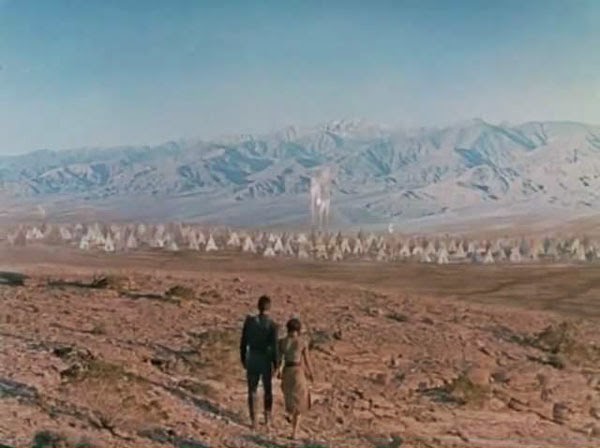There are many western
films with matte paintings. Some of them
have plenty of matte artistry like Gone with the wind, but that big amount of
paintings on a western film is not usual. Most frequently you can find one or
two mattes per film. I have chosen some of those titles on which I have just
found one or two mate paintings. Unfortunately most of these tricks are
uncredited.
Ambush at tomahawk gap (1953) Produced
by Columbia Pictures, with no FX credit. Lawrence Butler was Head of Effects department
at Columbia films from middle 40´s to late 60´s, but I think they didn’t have a permanent matte painter at Columbia
The upper part of the frame is
a painting showing the far away village on the valley and the surrounding
mountains.
The One and Only, genuine Family Band. (1968) The good think about Disney Films is that matt paintings are always credited. this time Alan Maley was in charge of paintng a distant view of Dakota.
Across the Wide Missouri
Whispering Smith (1948) A Paramount pictures
with Gordon Jennings and Farciot Edouard credited for Photographic
effects. Jan Domela, the resident matte
artist at Paramout must be responsible for the painting.
The Wyoming Mail (1950)
Produced by Universal pictures with no credit for FX, as usual at Universal
films before Albert Whitlock arrived from Disney. The matte paintings should be the work of
Russell Lawson.
Another Universal film, Cattle
drive (1951) This time with David S. Horsley credited for Special photography.
Russell Lawson again uncredited for his matte paintings.
Only the centre area of the
frame with the railroad on the plain is real. All the surrounding landscape is
painting
The same set of a cavalry fort was used on many Universal films. The first
one is from Column South (1953) The second from War Arrow (1953) Both paintings by Russell Lawson.
For War Paint (1953) the photographic effects were provided by Jack
Rabin Company. At that time he used to
team up with matte artist Irving Block but Rabin executed also some matte
paintings by himself, so either of them could have painted.
I found two beautiful matte paintings;
the last one at the end of the films is full painting with a tilt up camera movement from the
headstone to a glorious sky.
For Warner films was usual not
to find any VFX credit. Lou Lichtenfild
was in charge of matte paintings from early 50´s to late 60´s, and probably he
was responsible for those paintings.
I cannot close that small
article without mentioning the European westerns. Most of them were Italian and Spanish
productions during the 60´s.
Italian director,
cinematographer and tricks expert Mario Bava executed some in camera glass
shots on many films. He used to work
with some Italian artists like Amedeo
Gigli, who painted miniatures for him
during almost a decade. Mostly for sword and sandal films. Bava also used to use
cut out photos, pasted on glass. I guess he used that technique on The road to Fort Alamo
You just have to show around twenty
extras on Indian costume on a medium wide shots and then for the wide shot paint or paste photos of hundred Indians.
Spanish miniature artist Emilio Ruiz del Rio executed in camera glass shots very often for westerns filmed in Spain
West village painted by Emilio
Ruiz for Terrible Sheriff (1962) with a camera movement on the foreground painting.
For the film Charge of the
seven cavalry (1965) he painted an Indian camp with the same technique that allows
camera movement. The painting was hold
by two trunk threes behind the actors.
Another matte shot with an horizontal camera movement that follows the carriage entering the set from Cannon
from Cordoba



























